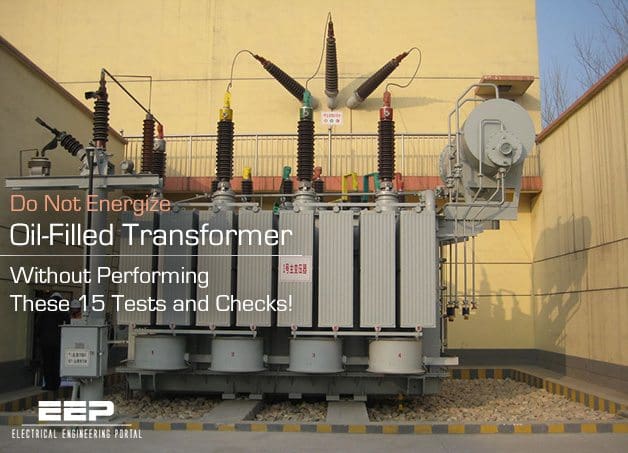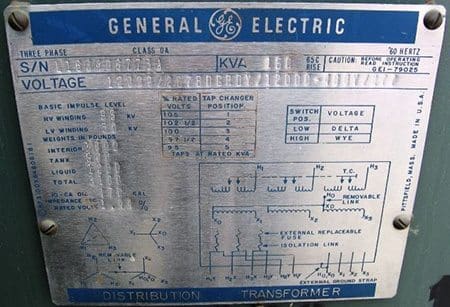
Do Not Energize Oil-Filled Transformer Without Performing These 15 Tests and Checks! (on photo 3-core type oil-immersed rectifier transformer 380kV; via electric-power-transformers.com)
Obligatory Checklist
The following tests and checks should be performed at a minimum to ensure that the transformer is ready to be energized. Do not energize the transformer without performing these tests and checks.
If any of below explained tests fail and transformer is energized anyway, it may lead to the serious hazard, and that’s not good ![]() That’s not what we want.
That’s not what we want.
Let’s see these 15 tests…
1. Insulating Fluid Test
Draw a fluid sample and test its dielectric strength. Dielectric strength of new fluid should be 26 kv or greater.

The breakdown voltage indicates how well insulating oil can withstand an electrical load and is therefore decisive for the operational efficiency of a transformer. The breakdown voltage is measured according to VDE 0370 part 5 (IEC 60156); photo credit: SIEMENS
2. Pressure Test
Check the transformer tank for leaks by pressurizing the tank with dry air or dry nitrogen through the pressure test fitting to a pressure of 3 to 4 PSIG. let the tank stand under pressure for one to two hours, then examine the tank and fittings for leaks. leaks above the fluid level can be detected by applying soap solution to all welds, joints, pipe fittings, and cable connections.
Upon completion of this test, reduce the internal pressure to 1 or 2 PSIG.

Repairing transformer oil-tank for leakage (photo credit: khia.belzona.com)
3. Insulation Megger Test
Perform a 1000-volt Megger test and a power factor test to ensure that none of the windings is grounded. See the complete procedure here.

Regular insulation testing is one of the most cost effective methods of identifying aging of transformer
4. Ratio Test
Perform a ratio test at each tap position to ensure that transformer coil ratios and tap changer connections are correct. Read the complete procedure of transformer turns ratio test step by step.
5. Continuity Test and Resistance Test
Perform a continuity check on each winding. Measure the winding resistance of each winding and compare results to factory test values.
6. Line Connections
In preparation for making line connections, check to make sure that all mating connector surfaces are clean and smooth. Connections must be tightened appropriately to prevent overheating and possible subsequent failure of the connection.
Connections to should be made with care to avoid placing undue stress on the bushings.

Oil-filled transformer bushings (photo credit: khia.belzona.com)
7. Tap Changer Setting
Check the tap changer setting to ensure it is set to the proper position for the required voltage. See an example of transformer tap-changer correct adjustment.

On-Line Oil Filtration for Load Tap Changer Compartment (photo credit: velcon.com)
8. Delta/Wye and Series/Multiple Switch Settings
Check delta/wye and series/multiple switch settings to make sure they are set correctly.
If these connections are made using an internal terminal board, check to ensure that these connections are made properly according to the chart on the transformer nameplate.

GE distribution transformer nameplate (photo credit: tucsontransformer.com)
9. Grounding
Check to ensure that the transformer tank is permanently and effectively grounded. The transformer tank ground pad is located near the bottom of the tank.
10. Wiring
Check wiring of control and alarm circuits (if provided) to make sure there are no loose connections and no damage to insulation.

Oil-filled transformer terminal box
11. Fluid level

Figure 1 – Liquid Level Gauge
Check to make sure the fluid level as indicated by the fluid level gauge is as follows:
12. Tank Finish
Check all painted surfaces to make sure that there is no damage or corrosion.
13. Bolted Connections
Check all bolted connections for tightness.

Oil transformer bolted connections (photo credit: polywater.com)
14. Tools
Check to make sure that all tools and equipment are accounted for and have been removed from the transformer.
15. Fluid Temperature
Read the fluid temperature gauge and make sure the temperature is no lower than minus 20°C before the unit is energized.

Figure 2 – Liquid Temperature gauge
Reference: Installation, Operation, and Maintenance of Medium Power Substation Transformers – Howard Industries